One large rutabaga, peeled and cubed into more or less bite-sized pieces, will serve four people easily. Coat in vegetable oil, sprinkle with salt, pepper and granulated garlic, and bake them at 350 in a well-oiled pan, turning occasionally to brown evenly. When tender, dust with dried herbs—sage, rosemary, marjoram, basil, rosemary, or a combination—spoon in a skillet, and toss with butter.
Camellia Apples
Satsuma Season
The Louisiana crop ripens from October until late November, and they’re the sweetest citrus you’re going to get all winter. Use satsumas like oranges, and if you’re feeling really froggy, here’s an ambitious recipe from “Louisiana Cookin.”
Satsuma Upside-Down Cake
3¾ cups sugar, divided
4 cups water
24 (¼-inch-thick) sliced satsumas
1 cup unsalted butter, softened
3 large eggs
1 teaspoon vanilla extract
3 cups all-purpose flour
½ cup yellow cornmeal
2 teaspoons baking powder
1 teaspoon salt
½ cup whole milk
1 teaspoon satsuma zest
½ cup fresh satsuma juice
Preheat oven to 350°. Line the bottom of a 9-inch spring-form pan with parchment paper, and prep with baking spray with flour. Sprinkle ¼ cup sugar in bottom of pan.
In a large skillet, stir together 1½ cups sugar and 4 cups water. Add satsuma slices, bring to a boil, then turn off heat. After 15 minutes, remove fruit with a slotted spoon, and place on a wire rack to drain. Reserve the syrup. After 30 minutes or so, place slices in prepared pan, overlapping slightly.
In a large bowl, beat butter and remaining 2 cups sugar with a mixer at medium speed until fluffy, 3 to 4 minutes, stopping to scrape sides of bowl. Add eggs, one at a time, beating well after each addition. Beat in vanilla. In a medium bowl, whisk together flour, cornmeal, baking powder, and salt; in a small bowl, whisk together milk, zest, and juice. Gradually blend flour and butter mixtures alternately with milk, beginning and ending with flour, beating just until combined after each addition.
Gently spoon batter over satsuma slices, cover with foil, and bake until a wooden pick inserted in center comes out clean, about 30 minutes. Let cool in pan for 15 minutes. Loosen edges with a knife, invert cake onto a serving plate, and remove parchment paper. Drizzle with ¼ cup syrup before serving.
Bobbie Gentry’s Cherry Cookie Bars
This recipe appeared in Bayou Cuisine (1970) and was credited to Edith Streetner of Greenwood, Gentry’s stepmother, who writes that it’s “Bobbie’s favorite recipe that she has loved since she was a little girl, and I always made them for her when she came home.”
These are two-in one cookie bars. They have a rich, buttery cream-colored layer below and scarlet cherries, coconut, and nuts in the layer on top.
Sift together 1 cup plain flour and 1/4 cup confectioner’s sugar. Cut in 1/2 c. butter until mixture resembles coarse meal. Press mixture firmly into the bottom of an ungreased 11×7 or 9×9 inch pan. Bake in a moderate (350) oven for 10 minutes. Sift together 1/4 c. plain flour 1/2 tsp. baking powder 1/2 teaspoon salt and 3/4 c. sugar. Add 2 eggs lightly beaten, then fold in 1/2 c. maraschino cherries, finely cut, 1/2 c. grated coconut, and 1/2 c. chopped nuts (walnuts, pecans, or almonds). Spread over a blind crust and bake in a moderate (350) oven 30-40 minutes. Cool and cut into bars or squares.
A Savory Dutch Baby
Whip into a froth two large eggs and a half cup each flour and whole milk. Season with salt and pepper and a scattering of shaved onion. Pour into a hot buttered skillet and pop into a very hot oven until puffed and browned. Topped with more onion and peppered ham. Serve with grated hard cheese and sour cream with chives.
Beth Ann’s Banana Bread
Cream a stick of butter with a cup of brown sugar. Blend in two beaten eggs, a teaspoon each vanilla and almond extract, and two very ripe mashed bananas.
Using a whip, stir in a mix of 2 cups plain flour sifted with 2 teaspoons baking powder, and a teaspoon each baking soda and salt. Mix and add enough almond milk to make a smooth batter, a little on the thin side.
Pour into a lined and oiled 9×5 loaf pan, and place in a 350 oven until the loaf pulls away from the pan, about an hour.
A Note on Sawmill Gravy
When the nation began to recover from its bloody Civil War, and on into the early 20th century, timber became the South’s biggest cash commodity. Logging camps and sawmills sprang up like mangling mushrooms in the great forests stretching from the Chesapeake Bay to Galveston. The deforestation of the southeast was an ecological calamity of continental proportions, but it provided a defeated, dispirited people with sustenance.
In my homeland of the middle South sawmill gravy is a staple for breakfast. This recipe makes a gracious plenty. Many folks I knew as a boy would keep a covered container of left-over gravy with whatever meats and biscuits weren’t eaten that morning. More often than not someone would spoon it over a piece of cornbread or a scoop of rice sometime during the day, and many nights found another batch being made on the stove.
North Mississippi Sawmill Gravy
This recipe will give you a flavorful gravy that is light-years better than that library paste you’re used to being served on breakfast buffets or in fast-food restaurants. Purists will decry my addition of a light stock to the mixture, but if they prefer a gloopy sausage-flavored white sauce, that’s because they just don’t know any better. I’m a firm believer that starch needs unfettered water in order to bloom properly.
Brown about a half-pound pork sausage in a little oil (you can use bacon drippings if you like). Break it up very well. When quite done, sprinkle in about two tablespoons plain flour, and blend until smooth. When flour begins to brown, stir in about a cup of water. Mix well. To this add enough milk to make a thin gravy. Reduce heat and cook down to a good consistency, perhaps a little lighter than you want, since it will thicken off heat. Salt if needed. I like it with a heft of black pepper.
Mississippi’s Greatest Chef
A writer, scholar, and an artist as well as the first and foremost chef of note from Mississippi, Howard Mitcham was a brilliant, stone-deaf, hard-drinking bohemian, raconteur, and bon vivant who knew and corresponded with the great and near-great.
A name chef during what Anthony Bourdain called “the early happy days before the glamorization of chefs”, a historian and an artist as well, we should remember Mitcham with gusto, with horns, drums, and songs. His Creole Gumbo and All That Jazz stands loud, proud and without a smidgen of pretension alongside any cookbook written in the past century, a robust ragout of recipes, music, art and lore. His Provincetown Seafood Cookbook, written with the same gregarious spirit, surely sates my fellow countrymen in Massachusetts as fully, but as his fellow Mississippian, Creole Gumbo is closer to my heart.
Mitcham nurtured, cultivated and matured his sprawling genius in the rich enclaves of Provincetown and New Orleans. For decades he was a spectacular bird of passage, summering on Cape Cod, wintering in the French Quarter and coming home to Montgomery County, Mississippi at times. His books trumpet a passion for seafood; his eloquence on oysters and clams, shrimp and fish seems to pant with restraint. Mitcham wants you to partake of everything he knows and loves with the same gusto he does in hearty sentences that growl with gruff humor and wry authority. “People think I’m sort of coo-coo to publish my trade secrets and recipes,” he wrote, “but to me good food is like love, it should be given as wide a distribution as possible.”
James Howard Mitcham, Jr. was born in Winona, Mississippi on June 11, 1917. His father, a house painter, died when he was a year old. His mother moved to Vicksburg to find work, leaving the infant Howard with her parents on their watermelon farm on Sawmill Road. At sixteen Mitcham became deaf from nerve damage resulting from spinal meningitis. For the rest of his life, Mitcham spoke with a thick, booming Southern accent, but used sign language and notes to abet his frequent incoherence. He grew up loving jazz, a love silence didn’t kill. “The last song he ever heard was Billie Holiday’s ‘Am I Blue?’”, his daughter Sabina said. “Whenever he’d sing it, it would just break my heart. At his birthdays he would place his hand on the bell of a sax to get the beat.”
Mitcham attended Greenville High School with lifelong friend Shelby Foote as well as Walker Percy. A May 30, 1934 clipping from “The Pica”, the GHS school newspaper, includes a column by Mitcham (“Rigmarole”) and three poems by Foote. A news article in the same issue notes: “Walker Percy, freshman at the University of North Carolina and member of last year’s graduating class, will journey to Germany for a three months’ tour of that country,” adding that “the tour will be made on foot and on bycicles (sic)”. After graduating high school, Mitcham moved to Vicksburg to live with his mother and began attending Louisiana State University. 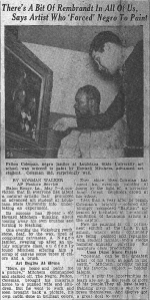
At some point in the late 1940s, Mitcham moved to Greenwich Village in New York City, where he ran an art gallery. During this time, he became the model for “the stone deaf man” in Marguerite Young’s epic work, Miss MacIntosh, My Darling. Sabina said that during Mitcham’s days in New York, Walker Percy would come to stay with him, often sleeping on the floor in Mitcham’s tiny apartment in the Village.
A little over a decade later, Mitcham’s support for civil rights was confirmed in another medium. Among the papers of Dr. James Silver at the University of Mississippi is a letter from Mitcham to Silver dated 1956 written in a strong articulate script thanking him for a letter and clipping from “the Jackson, Tenn. newspaper” and his vigorous support of Silver’s stance against a closed society. “You have certainly flung down the gauntlet in a manner that was badly needed,” Mitcham wrote. “I only hope you don’t get a potsherd in the urn with your name on it. To defend freedom of thought and expression in Mississippi these days is almost suicidal, they’re more afraid of truth than any other one thing, just can’t afford to face it, or the house of cards will fall down.” The year before, Howard received a letter from Faulkner thanking him for a painting.
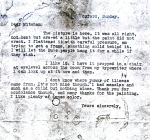
The picture is here. It was all right, not bent but arch-ed a little but the paint did not crack. I flattened it with careful pressure, am trying to get a frame, something solid behind it. I will let the Buie people hang it for a while if they wish.
I like it. I have it propped in a chair at eyelevel across the room from my typewriter where I can look up at now and then.
I don’t know where rumor of illness came from. It’s not mine though. I had measles and such as a child but nothing since. Thank you for condolence though, and many thanks for the painting. I like plenty of dense color.
Yours sincerely
Faulkner
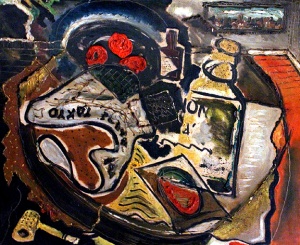
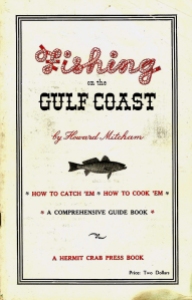
What makes Fishing on the Gulf Coast even more of a treasure are Mitcham’s beautiful woodcut prints of fish and marine life. Art (along with a passion for antique clocks and clockworks) provided Mitcham with a fruitful outlet for his talents throughout his life. The 1963 summer and winter issues of The Carolina Quarterly featured two portfolios with six of his woodcuts prints. Like his fellow Mississippi artist Walter Anderson, who also made woodcut prints, much of Mitcham’s work reflects a strong interest in classical mythology. 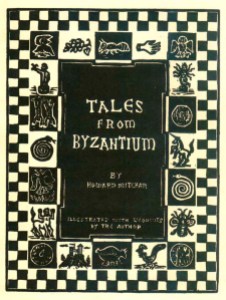
The quirk of fate or fortune that first took Mitcham from his home in the Deep South to the distant shores of Cape Cod is a matter rich for speculation, but he claims to have made his first visit there as early as 1948. Thereafter for most of his life, Mitcham divided his years between New Orleans and Provincetown. An editor of The Provincetown Advocate described Mitcham as “Artist, block print maker, chef par excellence, pro-beatnik, draughtsman and one of the most talented ‘nuts’ ever to come into Provincetown.” Mitcham maintained an art gallery on the Cape, painted signs and repaired clocks (one correspondent claims he published an article on antique clocks in Gentleman’s Quarterly). In the 1960s, Mitcham wrote a column in the Advocate called the “The Cape Tip Gourmet” and another called “The Cape Curmudgeon”. He wrote that the first place he headed when he first arrived in Provincetown, and most likely from then on, was Town Wharf. “It made my heart jump to see the enormous hauls of herring that the trap boats were bringing in,” Mitcham said. “But my gourmet’s heart was broken when I found out that this wonderful fish was being knocked down for two bucks and fifty cents a barrel and shipped off to the cat food factory.”
His abounding love for Provincetown bore prodigious fruit in 1976 with the publication of The Provincetown Seafood Cookbook, an unsurpassed ode to a food, a place and a people. Bourdain, who worked in Provincetown during the mid-1970s when he was attending (of all places) Vassar, knew Mitcham and in his Kitchen Confidential writes that “Howard was the sole ‘name chef’ in town.”
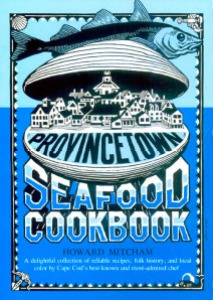
“We might not have understood Howard, but we understood his books, and while it was hard to reconcile his public behavior with the wry, musical and lovingly informative tone of his writings, we knew enough to respect the man for what he knew and for what he could do. We saw someone who loved food, not just the life of the cook. Howard showed us how to cook for ourselves, for the pure pleasure of eating, not just for the tourist hordes. Howard showed us that there was hope for us as cooks. That food could be a calling. That the stuff itself was something we could actually be proud of, a reason to live.”
In Provincetown, Mitcham bonded strongly with the local Portuguese community, where he made many deep and lasting friendships and his love for them shines from his works. In Fishing on the Gulf Coast, Mitcham claims he contacted the Portuguese Embassy to obtain a recipe, and The Provincetown Seafood Cookbook contains many, many more. “Transplanting the Azores Islanders to Provincetown was a great step forward because they brought with them their beautifully rambunctious cookery, and this husky, euphoric cuisine has quietly worked its way into Cape Cod and New England cookery in general,” he wrote. “I have been observing Portuguese cooks for twenty-five years, and I find that they have the following relative units of measurement: (1) a little, (2) some, (3) a bit more, (4) a lot, (5) plenty, (6) enough.”
Mitcham’s best-known work in my part of the world is Creole Gumbo and All That Jazz (1978), arguably the most embracive and best-written book about the food and people of southern Louisiana. The exuberance of this work needs many readings to encompass. In Creole Gumbo, Mitcham celebrates his love for the kaleidoscopic, carefree world of the Crescent City: its food, its history and, astoundingly, its music. 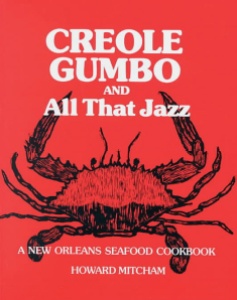

“At our last big party we boiled 400 pounds of shrimp and 400 fat crabs for 200 guests and we drank eight thirty-gallon kegs of beer,” Mitcham said. “For music we had Kid Thomas and his Algiers Stompers, the famous old gut-bucket jazz group from Preservation Hall, and the Olympia Funeral Marching Band”.
Sheraton notes that Creole Gumbo, like its predecessor The Provincetown Seafood Cookbook, deals (almost) exclusively with seafood, for which Mitcham had an avowed and lifelong passion, but it’s worth pointing out that with few exceptions (bananas Foster springs to mind) the recipes we associate most with New Orleans are seafood-based: trout amandine meuniere, oysters Rockefeller, seafood gumbo, pompano en papillote, the aforementioned barbecued shrimp (which, it must be said, resembles no other type of Southern barbecue) and many others. This emphasis on seafood provides a convenient point for a brief comparison with The Provincetown Seafood Cookbook. Two points must be emphasized: first, that one city sits on the edge of the North Atlantic, the other at the mouth of the Mississippi River; secondly, the ethnic make-up of places, New Orleans a hodge-podge of race and nationalities, Provincetown a New England enclave with an important Portuguese community. Geography plays an important role in the types of seafood used. Recipes for clams of all sorts and the fish of the North Atlantic (cod, haddock, bluefish, etc.) dominate the Provincetown Seafood Cookbook, while the emphasis in Creole Gumbo is on oysters, shrimp and such fish that thrive in the warm waters of the Gulf of Mexico (redfish, snapper, speckled trout, etc.) as well as the denizens of the fresh and brackish water environments along the Gulf: alligators, snapping turtles and catfish.
In 1981, The Hermit Crab Press published Maya O Maya! Rambunctious Fables of Yucatan. According to a synopsis by Creighton University, which owns one of the 500 published copies, the book is “a collection of humorous parodies of ancient lore about gods, statues, and rites. The first, ‘The World’s Strongest Cocktail,’ presents Ixnib, the god who invented the drink balche. The woodcut figures are reminiscent of Mayan statues in museums.”
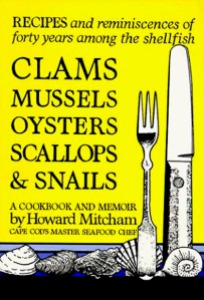
Mitcham shared his days between New Orleans and Provincetown, where he worked in local restaurants. He also became very much a fixture in the town; Jan Kelly, who wrote a food column for The Provincetown Advocate with Mitcham for years, described him as “brilliant, a great art lover and so well-read that there wasn’t a literary or mythical reference that he didn’t know. He was an absolute genius, terribly complicated at times, but never boring.” Mitcham died at the age of 79 on August 22, 1996, at Cape Cod Hospital. Mitcham once told Donnels he’d like to be buried in a Truro, Mass., cemetery beside an old clam digger friend of his, but at another time Donnels said, “We were sitting in Pat O’Brien’s, and he said if ever he died, he would like to be cremated and have his ashes scattered through the ventilating fan of the ladies room there.”
Mitcham’s ashes were spread over the ocean off Cape Cod.
Tarzan in the Garden
Many gardeners in Mississippi are familiar with Jewels of Opar, though with varying degrees of fondness. While the plant—native to tropical America—isn’t a noxious invader since this year’s plants and roots are eradicated by a substantial frost, Jewels of Opar (Talinum paniculatum) seeds lavishly, and once established, persists.
The plant was discovered on the “sea cliffs of Martinique and Santo Domingo” by Dutch botanist Baron Joseph von Jacquin during his travels to the Americas in the mid-18th century. Jacquin described the flowers as “small, numerous, red, and odorless,” likely the source of its common name in other parts of the world, “flame flower,” which brings us to our riddle. How did this modest little flower acquire a name so closely associated with one of literature’s greatest adventure heroes, Tarzan of the Apes.
Tarzan and the Jewels of Opar (1916) is a novel by American writer Edgar Rice Burroughs, the fifth in his series of twenty-four books about the title character Tarzan. As conceived by Burroughs, Opar is a lost colony of Atlantis located deep in the jungles of Africa, in which incredible riches have been stockpiled down through the ages. Tarzan first visits Opar in Burroughs’ second Tarzan novel, The Return of Tarzan (1913), and returns to the city time and again to replenish his personal wealth, for the second time in The Jewels of Opar, again in Tarzan and the Golden Lion (1923) and Tarzan the Invincible (1930).
If, in his novel, Burroughs had been described the jewels of the lost kingdom of Opar as “small, numerous (and), red” we would have a more substantial link with the plant in my garden, but, alas, he only writes that Tarzan saw only as “a great tray of brilliant stones.” No mention of color, no mention of size, though he does say that some were cut, some not. Perhaps an enterprising nurseryman out to sell dozens and dozens of delicate little flowers that came up in his greenhouses just happened to be a fan of Edgar Rice Burroughs and bestowed the exotic name on them in an effort to make them more appealing to gardeners.
But I find this explanation far too mundane. Instead, I prefer that the reason an insignificant flower collected on the volcanic slopes of Martinique became named for a “tray full of brilliant stones” from a fabled Atlantean kingdom remains a mystery we should cherish.
Pepper Vinegar
Most other Americans seem to think that the quintessential Southern hot sauce is a Tabasco-type mash, but restaurants across the middle South usually offer pepper vinegar as well.
Many people find pepper vinegar essential for flavoring greens, and some—like me—like it on peas and beans. Any hot pepper can be used, but long cayennes and sports are most common. Make it in jars, and serve it in a shaker bottle. Prick the peppers; you don’t have to stem them. Pack the containers until the lid just mushes the fruit. Use white vinegar, full strength, salted, something like a tablespoon of salt per quart of liquid. Heat the vinegar until just simmering. Add a few drops of vegetable oil in with the peppers before pouring in the hot vinegar. This adds a little kick, and no, I don’t know the science behind it. Some people add sugar, but don’t.
Pepper vinegar ages well over several weeks and you can infuse the peppers with more vinegar–no heating required, but shake well–to stretch a jar.










